Spread of the Latin script
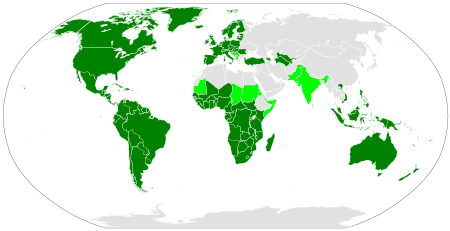
This article discusses the geographic spread of the Latin script throughout history, from its archaic beginnings in Latium to the dominant writing system on Earth in modernity.
The Latin letters' ancestors are found in the Etruscan, Greek and ultimately Phoenician alphabet. As the Roman Empire expanded in late antiquity, the Latin script and language spread along with its conquests, and remained in use in Italy, Iberia and Western Europe after the Western Roman Empire's disappearance. During the early and high Middle Ages, the script was spread by Christian missionaries and rulers, replacing earlier writing systems on the British Isles, Central and Northern Europe.
In the Age of Discovery, the first wave of European colonisation saw the adoption of Latin alphabets primarily in the Americas and Australia, whereas sub-Sahara Africa, Southeast Asia and the Pacific were Latinised in the period of New Imperialism. Realising that Latin was now the most widely used script on Earth, the Bolsheviks made efforts to develop and establish Latin alphabets for all languages in the lands they controlled in Eastern Europe, North and Central Asia. However, after the Soviet Union's first three decades, these were gradually abandoned in the 1930s in favour of Cyrillic. Some post-Soviet Turkic-majority states decided to reintroduce the Latin script in the 1990s after the 1928 example of Turkey. In the early 21st century, non-Latin writing systems were still only prevalent in most parts of the Middle East and North Africa and former Soviet regions, most countries in Indochina, South and East Asia, Ethiopia and some Balkan countries in Europe.
Protohistory
The Latin script originated in archaic antiquity in the Latium region in central Italy. It is generally held that the Latins, one of many ancient Italic tribes, adopted the western variant of the Greek alphabet in the 7th century BCE[1] from Cumae, a Greek colony in southern Italy – making the early Latin alphabet one among several Old Italic alphabets emerging at the time. The early Latin script was heavily influenced by the then regionally dominant Etruscan civilization;[2] the Latins ultimately adopted 22 of the original 26 Etruscan letters,[1] which derived from Western Greek as well.[2]
Antiquity
Along with the Latin language, the Latin writing system spread first spread over the Italian Peninsula with the rise of the Roman Republic, especially after 350 BCE. For example, the region of Umbria seems to have switched from its own script in the 2nd century BCE to Latin in the 1st.[3] Next were the lands surrounding the Western Mediterranean Sea: Sicily, Sardinia and Corsica, Africa Proconsularis, Numidia, Hispania, and Gallia Transalpina. This continued during the early period of expansion of the Roman Empire (c. 27 BCE – 117 CE) in regions such as Illyria, Rhaetia, Noricum, Dacia, Gaul, Belgica, western Germania, and Britannia. The eastern half of the Empire, including Greece, Macedonia, Asia Minor, the Levant, and Egypt, continued to use Greek as a lingua franca, but Latin was widely spoken in the western half, and as the western Romance languages evolved out of Latin, they continued to use and adapt the Latin alphabet.[1] Despite the loss of the Latin-speaking Western provinces, the Byzantine Empire maintained Latin as its legal language, under 6th-century emperor Justinian I producing the vast Corpus Juris Civilis that would have a major impact on Western European legal history from c. 1100 to 1900.[4] The Germanic peoples that invaded and gradually settled the Western Roman Empire between the 5th and 8th centuries, most notably the Franks (first as the Merovingian script, later the Carolingian minuscule), adopted the Latin script and spread it further.
Middle Ages
Latin Christianisation of Western, Central and Northern Europe
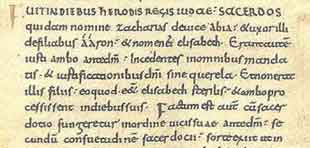
With the spread of Western Christianity during the Middle Ages, the Latin alphabet was gradually adopted by the peoples of Northern Europe who spoke Celtic languages (displacing the Ogham alphabet since the 5th century)[1] or Germanic languages (displacing earlier Runic alphabets since the 8th century)[1] or Baltic languages, as well as by the speakers of several Uralic languages, most notably Hungarian, Finnish and Estonian. The Latin script was introduced to Scandinavia in the 9th century, first in Denmark.[1] It reached Norway during the 11th-century Christianisation, but in two different forms: the Anglo-Saxon Insular script in Western Norway and the Carolingian minuscule in Eastern Norway.[5]
Slavic languages
The Latin script also came into use for writing the West Slavic languages and several South Slavic languages such as Slovene and Croatian,[6] as the people who spoke them adopted Roman Catholicism. The speakers of East Slavic languages generally adopted Cyrillic along with Orthodox Christianity. The Serbian language has come to use both scripts, whilst the Southeastern Slavic Bulgarian and Macedonian languages have maintained Cyrillic only.
Early modern period
As late as 1500, the Latin script was limited primarily to the languages spoken in Western, Northern, and Central Europe, Iberia and Italy. The Orthodox Christian Slavs of Eastern and Southeastern Europe mostly used Cyrillic, and the Greek alphabet was in use by Greek-speakers around the eastern Mediterranean. The Arabic script was widespread within Islamdom, both among Arabs and non-Arab nations like the Iranians, Indonesians, Malays, and Turkic peoples, as well as amongst Arab Christians. Most of the rest of Asia used a variety of Brahmic alphabets or the Chinese script.
Since the 15th and especially 16th centuries, the Latin script has spread around the world, to the Americas, Oceania, and parts of Asia and Africa (until about 1880 mostly limited to the coastal areas), and the Pacific with European colonisation, along with the Spanish, Portuguese, English, French, and Dutch languages.
Americas
In an effort to Christianise and 'civilise' the Mayans, the Roman Catholic bishop Diego de Landa of Yucatan ordered the burning of most Maya codices in July 1562, and with it the near destruction of the Mayan hieroglyphic script. He then rewrote the history of the Mayans in Spanish, and the Mayan language was romanised, leading to an enormous loss in culture.[7]
Latin letters served as the basis for the forms of the Cherokee syllabary developed by Sequoyah in the late 1810s and early 1820s; however, the sound values are completely different.
Southeast Asia and Pacific
The Latin script was introduced for many Austronesian languages, including the languages of the Philippines and the Malaysian and Indonesian languages, replacing earlier Arabic and indigenous Brahmic alphabets.
During the Dutch rule on Formosa (1624–1662), the island currently known as Taiwan, the Siraya language was given a Sinckan Latin alphabet by the Dutch, which lasted until the 19th century.
19th century
Africa
The Scramble for Africa (1881–1914), meaning the rapid occupation, colonisation and annexation of inland Africa by European powers, went hand in hand with the spread of literacy amongst native Africans, as the Latin script was introduced where there were other writing systems or none. Until the early 19th century, the Berber peoples in North Africa had two systems: originally Tifinagh, and, following the spread of Islam, the Arabic script as well.[8] French colonists, particularly missionaries and army linguists, developed a Berber Latin alphabet to make communication easier, especially for the Kabyle people in French Algeria. Since no great body of Berber literature existed, and the colonisers greatly helped improve literacy rates, the romanisation received much support, more so after Algerian independence (1962) when the French-educated Kabyle intelligentsia began to stimulate the transition and especially since the establishment of a standard transcription for Kabylie in 1970. Similar French attempts to latinise the Arabic language met much more resistance, were unsuccessful and eventually abandoned.[9]
Romania
As a Romance language, Romanian continued to be written in Latin script until the Council of Florence in 1439.[10] Increasingly influenced by Russia as the Greek Byzantine Empire declined and was gradually conquered by the Ottoman Empire in the 15th century, the Eastern Orthodox Church had begun promoting the Slavic Cyrillic. In the 19th century, the Romanians returned to the Latin alphabet under the influence of nationalism. The linguist Ion Heliade Rădulescu first proposed a simplified version of Cyrillic in 1829, but in 1838, he introduced a mixed alphabet containing 19 Cyrillic and 10 Latin letters, and an [i] and [o] that could be both. This 'transitional orthography' was widely used until the official adoption of a completely Latin Romanian alphabet in Wallachia (1860) and Moldavia (1863), that were gradually united since 1859 to become the Kingdom of Romania in 1881. Romanian intellectuals in Transylvania, then still part of Austria-Hungary, and scholars in Wallachia-Moldavia agreed to cleanse the language from all non-Latin elements (Greek, Magyar, Slavic, and Ottoman), and to emulate French wherever needed.[11]
Russian Empire
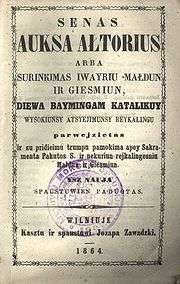
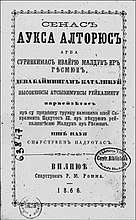
Tsar Nicholas I (r. 1826–1855) of the Russian Empire introduced a policy of Russification, including Cyrillisation. From the 1840s on, Russia considered introducing the Cyrillic script for spelling the Polish language, with the first school books printed in the 1860s.[12] The imperial government's attempts failed, however: the Polish population put up a tough resistance, as it saw its language as expressed in its Latin alphabet as a source of national pride, and threatened to rebel if it were to be abolished.[13]
The initially successfully enacted Lithuanian press ban (1865–1904) outlawed the use of Latin script, whilst encouraging writing Lithuanian texts in Cyrillic. Resistance grew as time went on: Lithuanian books were smuggled into the country, mainly from Lithuania Minor in East Prussia. Although the Russian authorities tried to seize them, they could not stop the rapid increase in forbidden titles from crossing the border. The Lithuanian ban, lifted in 1904, is widely felt to have stimulated the Lithuanian national movement and embracing the Latin script, rather than discouraging it.[14]
Vietnam
A romanization of Vietnamese was codified in the 17th century by the French Jesuit missionary Alexandre de Rhodes (1591–1660), based on works of the early 16th-century Portuguese missionaries Gaspar do Amaral and António Barbosa.[7] This Vietnamese alphabet (chữ quốc ngữ or "national script") was gradually expanded from its initial domain in Christian writing to become more popular among the general public, which had previously used Chinese-based characters.
During the French protectorate (1883–1945), colonial rulers made an effort to educate all Vietnamese, and a simpler writing system was found more expedient for teaching and communication with the general population. It was not until the beginning of the 20th century that the romanized script came to predominate written communication.[7] To further the process, Vietnamese written with the alphabet was made obligatory for all public documents in 1910 by issue of a decree by the French Résident Supérieur of the protectorate of Tonkin in northern Vietnam.
20th century
Albanian
Albanian used a variety of writing systems since its first attestation in the 12th century, especially Latin (in the north), Greek (in the south), Ottoman and Arabic (favoured by many Muslims). Attempts at standardisation were made throughout the 19th century, since 1879 led by the Society for the Publication of Albanian Writings, culminating in the 1908 Congress of Manastir when a single Latin script, Bashkimi, was chosen for the whole language.
Serbo-Croatian

Croatian linguist Ljudevit Gaj devised a uniform Latin alphabet for Croatian in 1835, while in 1818, Serbian linguist Vuk Karadžić had developed a Serbian Cyrillic alphabet. In the first half of the 19th century, the Illyrian movement to unite all Southern Slavs (Yugoslavs) culturally, and perhaps also politically, was quite strong, and efforts were made to create a unified literary language that would set the standard for all Yugoslav dialects. The Vienna Literary Agreement (March 1850) between writers from Croatia, Serbia and one from Slovenia was the most significant attempt, where some basic rules were agreed upon. In the 1860s, Vuk's orthography gained acceptance in Serbia, while a Yugoslav Academy of Sciences and Arts was founded in 1866 in Zagreb and the first 'Serbo-Croatian' grammar book by Pero Budmani was published in Croatia in 1867. In 1913, Jovan Skerlić proposed a compromise for a single writing system and dialect to create true language unity.[15] After World War I, political unity was realised in the Kingdom of Yugoslavia, but an agreement on scriptural unity for its population was never reached. The post-war Titoist Federal People's Republic of Yugoslavia made another attempt at achieving linguistic unity, but the 1954 Novi Sad Agreement only managed to get equality of Latin and Cyrillic, and an obligation for all citizens to learn both alphabets. With the return of ethnic nationalism in the 1980s, the two again became heavily associated with particular variants of the Serbo-Croatian language and thus with national identities. Exacerbated by the Yugoslav Wars that led to the disintegration of Yugoslavia in the 1990s, nationalists on all sides resumed insisting Croatian, Bosnian, Serbian and Montenegrin were distinct languages in their own right, undermining the project of Serbo-Croatian linguistic unity.
The Bosnian language was originally primarily expressed in the Cyrillic-type Bosančica since the 11th century (originally alongside the older Glagoljica), but it was gradually driven extinct in the 18th century after the Ottoman introduction of the Perso-Arabic script-type Arebica (15th–20th century).[16] Eventually, most Bosnians adopted the Croatian-derived Latinica or Latin script –originally introduced by the Catholic Franciscans[16]– in the course of the 20th century, standardised in the 1990s.
Middle East and North Africa
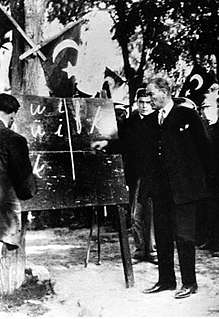
In 1928, as part of Mustafa Kemal Atatürk's reforms, the new Republic of Turkey adopted the Turkish Latin alphabet for the Turkish language, replacing a modified Arabic alphabet.[17]
In the 1930s and 1940s, the majority of Kurds replaced the Arabic script with two Latin alphabets. Although the only official Kurdish government uses an Arabic alphabet for public documents, the Latin Kurdish alphabet remains widely used throughout the region by the majority of Kurdish-speakers.
During the late 20th century decolonisation, Pan-Arabism and Arab nationalism expressed themselves in anti-Western tendencies, including hostility towards the Latin script. It was banned in some places such as Libya after Moammar Gaddafi's 1969 coup, in favour of exclusive Arabic script.
Soviet Union
Since at least 1700, Russian intellectuals have sought to Latinise the Russian language in their desire for close relations with the West.[13] The Bolsheviks had four goals: to break with Tsarism, to spread socialism to the whole world, to isolate the Muslim inhabitants of the Soviet Union from the Arabic-Islamic world and religion, and eradicate illiteracy through simplification.[13] They concluded the Latin alphabet was the right tool to do so, and after seizing power during the Russian Revolution of 1917, they made plans to realise these ideals.[13]
Although progress was slow at first, in 1926 the Turkic-majority republics of the Soviet Union adopted the Latin script, giving a major boost to reformers in neighbouring Turkey.[18] When Mustafa Kemal Atatürk adopted the new Turkish Latin alphabet in 1928, this in turn encouraged the Soviet leaders to proceed.[13] The Commission to romanise the Russian alphabet completed its work in mid-January 1930. But on 25 January 1930, General Secretary Joseph Stalin ordered the stop of the romanisation of Russian.[13] The Latinisation of non-Slavic languages within the USSR continued until the late 1930s, however. Most of the Turkic-speaking peoples of the Soviet Union, including Tatars, Bashkirs, Azerbaijani or Azeri, Kazakh (1929–40[19]), Kyrgyz and others, used the Latin-based Uniform Turkic alphabet in the 1930s; but, in the 1940s, all were replaced by Cyrillic.
Post-Soviet states
The Russian conquest of Transcaucasia in the 19th century split the Azerbaijani language community across two states, the other being Iran. The Soviet Union promoted development of the language, but set it back considerably with two successive script changes[20] – from the Persian to Latin and then to the Cyrillic script – while Iranian Azerbaijanis continued to use the Persian as they always had. Despite the wide use of Azerbaijani in the Azerbaijan Soviet Socialist Republic, it did not become the official language of Azerbaijan until 1956.[21] After achieving independence from the Soviet Union 1991, the new Republic of Azerbaijan decided to switch back to the Latin script.
Two other newly independent Turkic-speaking republics, Uzbekistan, and Turkmenistan, as well as Romanian-speaking Moldova on 31 August 1989[22][23][24], officially adopted Latin alphabets for their languages. In 1995, Uzbekistan ordered the Uzbek alphabet changed from a Russian-based Cyrillic script to a modified Latin alphabet, and in 1997, Uzbek became the sole language of state administration.[25] Kazakhstan, Kyrgyzstan, Iranian-speaking Tajikistan, and the breakaway region of Transnistria kept the Cyrillic alphabet, chiefly due to their close ties with Russia.
21st century
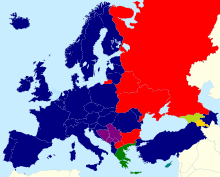
Scripts in Europe in the 2010s.
Latin
Cyrillic
Latin & Cyrillic
Greek
Greek & Latin
Georgian
Armenian
|
Russian Federation
In 1999, the Russian Republic of Tatarstan proposed to convert the Turkic Tatar language to Latin script in order to bring it into the modern world of the Internet. There was opposition from both inside and outside Tatarstan, with Tatars arguing it would threaten their national identity and to sever their ties to the past. The Russian State Duma rejected the proposal. President Vladimir Putin said that a Tatar move from Cyrillic to Latin would 'threaten the unity of the Russian Federation'. In 2002, Putin therefore enacted a law that made the use of Cyrillic mandatory for all languages in all autonomous republics of Russia.[13]
Kazakhstan
Unlike its Turkic neighbours, Kazakhstan did not move towards Latinisation after obtaining statehood in 1991. This was motivated by pragmatic reasons: the government was wary to alienate the country's large Russian-speaking minority, and due to the economic crisis in the early 1990s, a transition was considered fiscally unfeasable at the time.[26]
In 2006, President Nursultan Nazarbayev requested the Ministry of Education and Science to examine the experiences of Turkey, Azerbaijan, Turkmenistan and Uzbekistan, which had all switched to Latin letters in the 20th century. The ministry reported in the summer of 2007 that a six-step plan, based primarily on the Uzbekistan model, should be implemented over a 12-to-15-year period at the cost of about $300 million. Aside from integrating Kazakhstan into the global economy, officials have also argued it would help the development of a Kazakh national identity separate from Russia.[26] In 2007, Nazarbayev said the transformation of the Kazakh alphabet from Cyrillic to Latin should not be rushed, as he noted: "For 70 years, the Kazakhstanis read and wrote in Cyrillic. More than 100 nationalities live in our state. Thus we need stability and peace. We should be in no hurry in the issue of alphabet transformation".[27]
In 2015, the Kazakh government announced that the Latin script would replace Cyrillic as the writing system for the Kazakh language by 2025.[28] In 2017, Nazarbayev said that "By the end of 2017, after consultation with academics and representatives of the public, a single standard for the new Kazakh alphabet and script should be developed." Education specialists are to be trained to teach the new alphabet and provide textbooks beginning in 2018. The romanisation policy is intended to modernise Kazakhstan and increase international cooperation.[19]
Montenegro
There is ongoing discussion in Montenegro about how to call the "Montenegrin" language, which is mutually intelligible with the other standardised versions of Serbo-Croatian: Serbian, Croatian and Bosnian. These debates focus on the perceived linguistic differences between Montenegrin and related variants, but also on national and political identification. Montenegro practices digraphia: there are two official Montenegrin alphabets, one Latin and one Cyrillic. In electoral campaigns after 2000, especially the 2006 independence referendum, Latin has come to symbolise closeness to Western countries, including Montenegro's historical ties to Venice, and independence from Serbia; on the other hand, Cyrillic is taken to signify unity with Serbia and closeness to the East.[29] In general, proponents of calling the language "Montenegrin" – including the government – tend to favour the Latin script, whereas supporters of "Serbian" prefer Cyrillic.
Serbia
Under the Constitution of Serbia of 2006, Cyrillic script is the only one in official use.[30] Nonetheless the Latin script is widely used. Minister Vladan Vukosavljević proposed in 2017 to support the Latin script[31]
See also
- Latinisation of names
- Metrication
- Romanisation, conversion of a text in Latin (or Roman) letters
References
- 1 2 3 4 5 6 Kamusella, Tomasz (2008). The Politics of Language and Nationalism in Modern Central Europe. Houndmills: Springer. pp. 418–419. ISBN 9780230583474. Retrieved 6 June 2017.
- 1 2 Encarta-encyclopedie Winkler Prins (1993–2002) s.v. "Etrusken. §2. Taal en schrift". Microsoft Corporation/Het Spectrum.
- ↑ Encarta-encyclopedie Winkler Prins (1993–2002) s.v. "Umbrië. §1. Geschiedenis". Microsoft Corporation/Het Spectrum.
- ↑ Encarta-encyclopedie Winkler Prins (1993–2002) s.v. "Corpus Iuris Civilis".
- ↑ Flom, George T. (1915). "On the earliest history of the Latin script in Eastern Norway". Publications of the Society for the Advancement of Scandinavian Study. Society for the Advancement of Scandinavian Study. 2 (2): 92–106. JSTOR 40914943.
- ↑ Encarta-encyclopedie Winkler Prins (1993–2002) s.v. "Kroatië. §5. Geschiedenis". Microsoft Corporation/Het Spectrum.
- 1 2 3 Andresen, Julie Tetel; Carter, Phillip M. (2016). Languages in the World: How History, Culture, and Politics Shape Language. John Wiley & Sons. p. 106. ISBN 9781118531280. Retrieved 6 June 2017.
- ↑ Larbi, Hsen (2003). "Which Script for Tamazight, Whose Choice is it ?". Amazigh Voice (Taghect Tamazight). New Jersey: Amazigh Cultural Association in America (ACAA). 12 (2). Retrieved 17 December 2009.
- ↑ Souag, Lameen (2004). "Writing Berber Languages: a quick summary". L. Souag. Archived from the original on 2005-07-30. Retrieved 7 June 2017.
- ↑ "Descriptio_Moldaviae". La.wikisource.org. 1714. Retrieved 2014-09-14.
- ↑ Kamusella, Tomasz (2008). The Politics of Language and Nationalism in Modern Central Europe. Houndmills: Springer. p. 209. ISBN 9780230583474. Retrieved 6 June 2017.
- ↑ "Cyrylica nad Wisłą". Rzeczpospolita (in Polish). 2012.
- 1 2 3 4 5 6 7 Andresen, Julie Tetel; Carter, Phillip M. (2016). Languages in the World: How History, Culture, and Politics Shape Language. John Wiley & Sons. p. 110. ISBN 9781118531280. Retrieved 7 June 2017.
- ↑ "Lithuania – History – Russian Rule". Encyclopædia Britannica. Retrieved 6 June 2017.
- ↑ Greenberg, Robert D. (2004). Language and Identity in the Balkans: Serbo-Croatian and Its Disintegration. Oxford: Oxford University Press. p. 55. ISBN 9780191514555. Retrieved 7 June 2017.
- 1 2 Čuvalo, Ante (2010). The A to Z of Bosnia and Herzegovina. Lanham: Rowman & Littlefield. p. 26. ISBN 9780810876477. Retrieved 6 June 2017.
- ↑ Encarta-encyclopedie Winkler Prins (1993–2002) s.v. "Turkse talen. Microsoft Corporation/Het Spectrum.
- ↑ Zürcher, Erik Jan. Turkey: a modern history, p. 188. I.B.Tauris, 2004. ISBN 978-1-85043-399-6
- 1 2 "Kazakhstan spells out plans for alphabet swap". Deutsche Welle. 4 January 2017. Retrieved 6 June 2017.
- ↑ "Alphabet Changes in Azerbaijan in the 20th Century". Azerbaijan International. Spring 2000. Retrieved 21 July 2013.
- ↑ Language Commission Suggested to Be Established in National Assembly. Day.az. 25 January 2011.
- ↑ (in Romanian) Horia C. Matei, "State lumii. Enciclopedie de istorie." Meronia, București, 2006, pp. 292–294
- ↑ Andrei Panici (2002). "Romanian Nationalism in the Republic of Moldova" (PDF). American University in Bulgaria. pp. 40 and 41. Archived from the original (PDF) on 19 July 2011. Retrieved 9 October 2013.
- ↑ "Legea cu privire la functionarea limbilor vorbite pe teritoriul RSS Moldovenesti Nr.3465-XI din 01.09.89 Vestile nr.9/217, 1989" [The law on use of languages spoken in the Moldovan SSR No.3465-XI of 09/01/89]. Moldavian SSR News, Law regarding the usage of languages spoken on the territory of the Republic of Moldova (in Romanian). Archived from the original (DOC) on 19 February 2006. Retrieved 11 February 2006.
[Translation] The Moldavian SSR supports the desire of the Moldovans that live across the borders of the Republic, and considering the existing linguistic Moldo-Romanian identity – of the Romanians that live on the territory of the USSR, of doing their studies and satisfying their cultural needs in their native language.
- ↑ Dollerup, Cay. "Language and Culture in Transition in Uzbekistan". In Atabaki, Touraj; O'Kane, John. Post-Soviet Central Asia. Tauris Academic Studies. pp. 144–147.
- 1 2 Paul Bartlett (3 September 2007). "Kazakhstan: Moving Forward with Plan to Replace Cyrillic with Latin Alphabet". EurasiaNet. Open Society Foundations. Retrieved 7 June 2017.
- ↑ Kazakhstan should be in no hurry in Kazakh alphabet transformation to Latin: Nazarbayev, Kazinform, December 13, 2007 Archived 16 September 2016 at the Wayback Machine.
- ↑ Kazakh language to be converted to Latin alphabet – MCS RK. Inform.kz (30 January 2015). Retrieved on 2015-09-28.
- ↑ Kolstø, Pål (2016). Strategies of Symbolic Nation-building in South Eastern Europe. Routledge. p. 169. ISBN 9781317049357. Retrieved 7 June 2017.
- ↑ Article 10 of the Constitution of the Republic of Serbia (English version Archived 14 March 2011 at the Wayback Machine.)
- ↑ http://www.informer.rs/vesti/politika/137537/VUKOSAVLJEVIC-Cirilica-ugrozena-moramo-spasiti